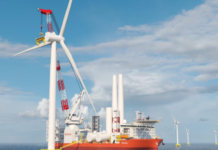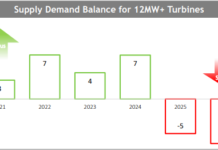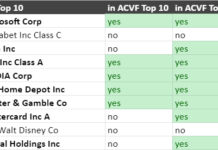Update:You can find a comparison of FAN with PWND. a more recent wind ETF here.
Since I last covered clean energy mutual funds and ETFs, the sector has seen the launch of two solar ETFs (KWT the Market Vectors Solar Energy ETF from VanEck, and TAN, the Claymore/MAC Global Solar Energy ETF.) Continuing in the tradition of cute ticker symbols, First Trust’s new global wind energy ETF is FAN.
I recommend that investors stay away from the (very expensive) green energy mutual funds, and invest either in one of the ETFs, or if they have a few tens of thousands of dollars to invest and are willing to roll up their sleeves a little, they buy a representative sample of the stocks (a "tracking portfolio") held by the mutual funds and ETFs, and save further on expenses.
The Problem with Tracking
The difficulty of tracking portfolios in clean energy for North American investors is that the wind sector is dominated by European companies, which can require considerable knowledge and cost to purchase. This is why, in the past, I preferred GEX, the Market Vectors Global Alternative Energy ETF. With the introduction of FAN, that problem is now solved. The Fund’s top three holdings, Vestas, REPower, and Gamesa are the world’s leading wind turbine manufacturers, and between them control approximately half of the worldwide market for turbines. Vestas alone has 23 percent of the worldwide market for wind turbines. Wind power is the largest source of renewable electricity after hydropower, and also the fastest growing renewable electricity source. It is also one of the most economical, producing power at a price comparable to the cost of generation from a newly built coal plant or natural gas turbine, and even cheaper in some locations.
The only major wind manufacturers in which a North American investor can easily buy are General Electric (GE) and Siemens (SI). Since these are large conglomerates, wind turbines are only a small fraction of their business. Both also have extensive exposure to other clean energy sectors, which is why they are included in the example portfolio below.
Bright Contrast
In marked contrast, the new Solar ETFs do not greatly add to a retail investor’s ability to invest in the solar space. There are more public solar companies than I keep track of, so aside from speculating on short term movements of the solar sector, I see little reason to use the Solar ETFs. Exposure to solar can be easily accomplished through individual stocks, or as part of the broader clean energy ETFs.
I personally tend to underweight solar most of the time. While I believe the solar sector will be a tremendous growth story, I also feel solar’s potential is already well appreciated by investors. This makes it difficult to find well valued solar companies.
A Model Portfolio
How would FAN be used as part of a larger clean energy portfolio? If I had $20,000 to invest in clean energy companies today, for an investor with an above average risk tolerance, here’s what it would look like (note, this portfolio is intended only as an educational example, not individual investment advice. The particular companies chosen for each sector would also change due to changes in valuation, and a smaller (larger) portfolio or higher (lower) commissions would lead to fewer (more) companies being included.
| Transport | $7,000 | |
| Bus – New Flyer (NFYIF) | $3,000 | |
| Rail – Portec Rail Products (PRPX) | $1,500 | |
| Rail – Greenbreier (GBX) | $1,500 | |
| Batteries – Electro Energy (EEEI) | $1,000 | |
| Power | $8,000 | |
| Wind – FAN | $2,000 | |
| Transmission&Wind – Composite Tech Corp (CPTC) | $1,000 | |
| Geothermal – Ormat (ORA) | $1,000 | |
| Inverters – SatCon (SATC) or Xantrex (XARXF) | $1,000 | |
| Storage – Active Power (ACPW) or Maxwell (MXWL) | $1,000 | |
| Efficiency – Cree, Inc (CREE) | $1,000 | |
| Efficiency – Waterfurnace (WFIFF) | $1,000 | |
| Diversified (see note *) | $5,000* | |
| Diversified – < a href="http://www.altenergystocks.com/archives/2008/01/how_green_are_your_earnings_1.html">General Electric (GE) | $1,000* | |
| Diversified – Sharp (SHCAY) | $1,000* | |
| Diversified – ABB (ABB) | $1,000* | |
| Diversified – Johnson Controls (JCI) | $1,000* | |
| Diversified – Owen Corning (OC) | $1,000* | |
*Note: if I were investing as part of a larger portfolio, I would actually invest about $4,000 in each of the "diversified" companies (a total of $20,000 rather than $5,000), and reduce the broader portfolio’s allocation to general large cap stocks by $15,000 to compensate for the limited exposure of these companies to clean energy.
This portfolio is not similar in composition to the existing ETFs… instead it heavily over weights my favorite sectors – efficient transport, and grid infrastructure, while almost ignoring popular sectors such as solar. I do like wind, on the other hand, so FAN is a useful part of the portfolio, in addition to the wind exposures from CPTC, the inverter stock, and the diversified conglomerates.
DISCLOSURE: Tom Konrad and/or his clients have long positions in Gamesa, GE, SI, NFYIF, PRPX, GBX, EEEI, CPTC, ORA, STAC, XARXF, ACPW, MXWL, CREE, WFIFF, GE, SHCAY, ABB, JCI, OC.
DISCLAIMER: The information and trades provided here are for informational purposes only and are not a solicitation to buy or sell any of these securities. Investing involves substantial risk and you should evaluate your own risk levels before you make any investment. Past results are not an indication of future performance. Please take the time to read the full disclaimer here.








Thanks for the excellent post. The hypothetical tracking portfolio is a very interesting thought exercise and spurs many ideas. Thanks for sharing.